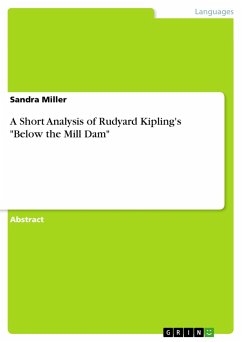Abstract from the year 2004 in the subject Didactics - English - Literature, Works, James Cook University (James Cook University), course: Critical Reading, language: English, abstract: "Below the Mill Dam" is set at Robert's Mill in the English countryside at or about the time of the story's publication (1902). Rudyard Kipling had just returned from Africa, where he had experienced the disastrous effects of the Boer War and witnessed such things as the British invention of concentration camps. He was alarmed by the ignorance of British politicians: "Conservative Balfour government's dead cultured aristocratic hand barred the way to a wider, less class-ridden British Empire" (Wilson 226). Kipling was pessimistic that Britain could uphold her imperial role as the world's leading nation, moreover, he was "extremely uneasy with, and critical of, unquestioned traditions, ruling-class hierarchies, and complacent establishments" (Lee 12). Fairly late in his life, in 1902, Kipling decided to live in Sussex in England. Shortly after, he had electricity installed in his house - which was not common at that time - and a sign that he was generally interested in and fascinated by new technology; he installed a turbine, a generator and associated equipment in the watermill in his own garden. Allegorical or symbolic tales, such as "Below the Mill Dam" convey Kipling's passion for machinery and technology. The story reflects Kipling's views about the changing environment, political atmosphere and the technical innovations that were transforming industry and the modes of production in farming, their impact on the landscape and on living conditions. Kipling disguised his plot as a fable, probably to avoid resentment from the establishment. In writing a political fable, he was able to express his "alarm and dismay at England's apparent inability to address herself socially, imperially, culturally and technologically to the future" (Page 69). Kipling uses allegorical language throughout the dialogues as a means of mockery and satire about forces which want to preserve tradition against the new emerging forces that are pressing for change and development.








